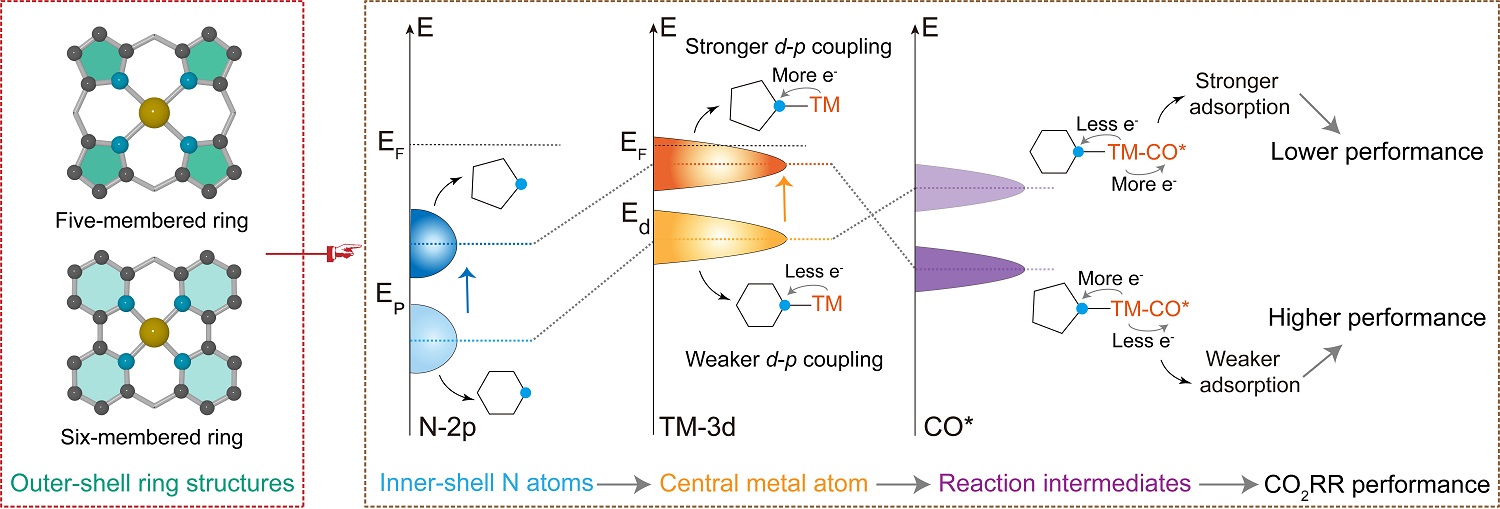
Recently, our team led by Researcher Xiaodong Wang and Researcher Jian Lin, in collaboration with Professor Sen Lin's team from Fuzhou University, has made new progress in the research on the regulation of the outer structure of single-atom catalysts and their mechanisms of action.
Since the concept of single-atom catalysis was proposed, it has become one of the research hotspots in the field of heterogeneous catalysis. This work proposes a "bottom-up" design strategy for single-atom catalysts, constructing single-atom catalysts with pentagonal and hexagonal ring geometries at the periphery, and reveals the mechanism of the peripheral effect of single atoms. The research found that compared to iron (Fe) single atoms coordinated with pyridine nitrogen in a hexagonal ring, Fe single atoms coordinated with pyrrole nitrogen in a pentagonal ring have a higher valence state and can enhance the CO2 electroreduction performance. Various characterization and theoretical calculations show that the d-p coupling interaction between the single-atom Fe and the adjacent pyrrole nitrogen atom in the five-membered ring is strengthened, leading to an upward shift of the d-orbitals of single-atom Fe. This results in appropriate adsorption strength for *COOH and *CO intermediates, thereby improving catalytic activity. Furthermore, the team extended the peripheral effect to other M-N-C single-atom systems, such as nickel (Ni), and found similar effects, indicating that regulating the peripheral geometric structure to optimize single-atom center catalytic performance has certain universality.
Additionally, the team studied the influence of the distribution of peripheral nitrogen species on the single-atom catalyst. They found that a random distribution of peripheral nitrogen could mildly adjust the adsorption strength of iridium (Ir) single-atom catalysts towards reaction intermediates, which helps to simultaneously improve the activity and selectivity in propane dehydrogenation reactions. This research deepens the understanding of how peripheral species influence single-atom catalysts.
The team, led by Xiaodong Wang and Jian Lin, has long been dedicated to the fundamental and applied research on the structural regulation of single/double-atom and sub-nanometer catalysts, achieving a series of advancements in areas such as the effect of the single-atom center microenvironment (Nat. Catal., 2022; J. Am. Chem. Soc., 2023; Angew. Chem. Int. Ed., 2024; Chem. Eng. Sci., 2024; Small, 2025) and synergistic catalysis in double atoms (Adv. Mater., 2022; Angew. Chem. Int. Ed., 2023; J. Am. Chem. Soc., 2024; Angew. Chem. Int. Ed., 2024). This work expands the research to the precise regulation of the single-atom peripheral environment, offering new ideas for the design of efficient single-atom catalysts.
The related progress on the peripheral geometric structure effect was published in Angewandte Chemie International Edition under the title "Outside-in Design of Single-Atom Catalysts: Linking Specific Peripheral Geometry to Defined CO2 Reduction Performance," and was selected as a Hot Paper. The research on the distribution of peripheral species was published in Angewandte Chemie International Edition under the title "Regulating Peripheral Nitrogen Dopants in Single-Atom Catalysts to Enhance Propane Dehydrogenation," and was selected as a VIP article. A perspective on the peripheral effects of single-atom catalysis was published in Coordination Chemistry Reviews under the title "Peripheral Effect Promotes Single-Atom Catalysis." These works were supported by the National Natural Science Foundation's "Single-Atom Catalysis" Basic Science Center Project, the National Natural Science Foundation, the Liaoning Provincial Xingliao Talent Program, and the Youth Innovation Promotion Association of the Chinese Academy of Sciences.
Paper Link:https://doi.org/10.1002/ange.202511184;https://doi.org/10.1002/anie.202416912;https://doi.org/10.1016/j.ccr.2025.216649